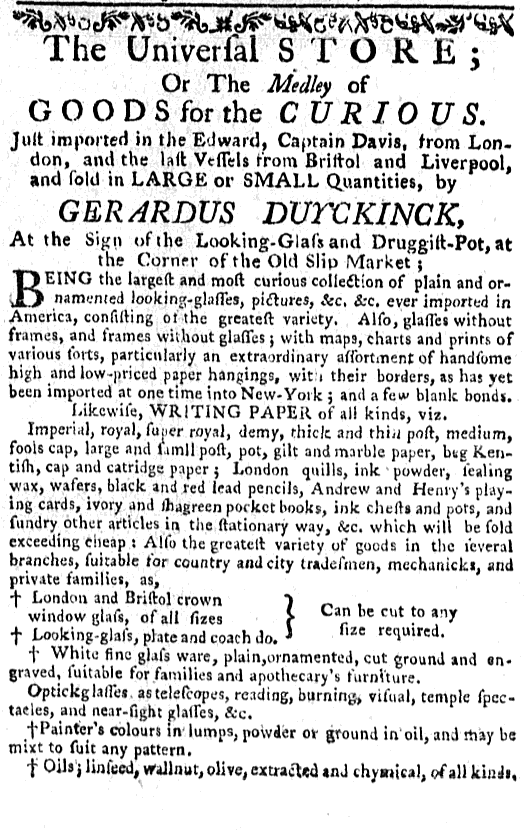GUEST CURATOR: Jordan Russo
What was advertised in a colonial American newspaper 250 years ago today?

“BEING the largest and most curious collection …”
In this advertisement Gerardus Duyckinck described the merchandise in his “Universal STORE” as a “Medley of GOODS for the CURIOUS.” Duyckinck sold “plain and ornamented looking-glasses” and “maps, charts and prints of various sorts.” I imagine the items in Duyckinck’s store were not sold everywhere else or else it would not have made sense to call them “GOODS for the CURIOUS.”
Duyckinck sold items for a variety of customers. Some of merchandise was high end while others was not. For example, his glassware was “plain” or “ornamented.” The differences in merchandise meant that the prices varied between items. Duynkinck said that he had “high and low-priced paper hangings.” Duycknick was not attempting to sell his items to one type of customer; he had items and prices welcoming to all.
T.H. Breen notes that “British imports initially flowed into the households of the well-to-do. These are the goods that catch our eyes in modern museums and restored colonial homes.”[1] When we visit museums today, we are most likely to see the sort of chic merchandise that Duynkinck sold to elite customers.
**********
ADDITIONAL COMMENTARY: Carl Robert Keyes
Historians of eighteenth-century consumer culture and material culture frequently discuss the sense of wonder that colonists experienced as they encountered an expanding array of goods that they purchased and put to use for a variety of purposes. Some goods were completely utilitarian; others were luxury items. Some denoted conspicuous consumption; most testified to the identity of the consumer in one fashion or another.
In some instances historians have carefully excavated the sense of excitement that colonists felt when confronted with new consumer choices. For instance, the standard list advertisement (with its heavy and dense format) may not seem especially exciting when viewed through modern eyes, but thick descriptions of how such lists presented a new world of imagination, sensation, and possession to eighteenth-century consumers uncover raucous enthusiasm.
Jordan has chosen an advertisement that does not require quite as much excavation. Gerardus Duyckinck verbalized the sense of wonder and excitement that he knew consumers felt, mobilizing it to bring customers into his “Universal STORE.” He offered a variety of specialty goods among his “Medley of GOODS for the CURIOUS.” He deployed hyperbole to describe his wares, which included “the largest and most curious collection” of looking glasses “ever imported in America, consisting of the greatest variety.” He stocked paper hangings (wallpaper today): “an extraordinary assortment … as has yet been imported at one time into New-York.” His general merchandise included “the greatest variety of goods in the several branches, suitable for country and city tradesmen, mechanicks, and private families.”
What would it have been like to visit Duyckinck’s shop? Was he as much of an entrepreneur, an early modern carnival barker, in person as he sounded in his advertisement? Interacting with the shopkeeper may have been an important part of the entertainment involved in shopping at his establishment, just as significant as the pleasures of inspecting his merchandise and exercising choice in selecting among his wares.
**********
[1] T.H. Breen, “An Empire of Goods: The Anglicization of Colonial America, 1690-1776,” Journal of British Studies 25, no. 4 (October 1986): 487.
